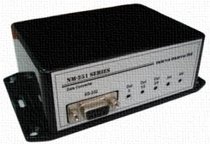|
NM-251D-ZDA filter/ converter with 5 buffered outputs (User Guide)
|
Price ... 240.00 EURO
|
Introduction
The NM-251D-ZDA is a part of the NM-251 Series family and is programmed to function as a GPS signal filter/converter that produces the $GPZDA sentence from any GPS capable of transmitting the $GPRMC string. The NM-251D-ZDA is designed to be used for interfacing a GPS that does not transmit the $GPZDA sentence with systems such as the VDR or ECDIS that require the time and date to be processed from the $GPZDA string only. The produced $GPZDA sentence is appended to the rest of the transmitted GPS strings and distributed to each of the five buffered output ports.
Operation
The NM-251D-ZDA acquires the NMEA-0183 sentences from the first input port only. If the string is not the $GPRMC it is immediately transmitted to the five outputs ports. In the case that a $GPRMC sentence is received the NM-251D-ZDA processes the time and date data and produces the $GPZDA string. Both the $GPRMC and $GPZDA are then transmitted to the five buffered outputs. If no $GPRMC sentence is received the NM-251D-ZDA functions as a pass through one to five channel NMEA-0183 multiplier.
Input Port
The NM-251D-ZDA has one input port enabled that can be connected to any GPS capable to output NMEA-0183 signals. The input port is optoisolated as specified in the NMEA-0183 protocol, thus the data(-) pole should never been connected to the NM-251DZDA ground. If the GPS talker port is single ended, connect that terminal to the Ina(+) and tide the Ina(-) to the instrument’s ground. If a RS-232 signal level is connected, the ground pole (GND) should be connected to Ina(+) and the data pole (TXD) to Ina(-).
The NM-251D-ZDA input port can acquire NMEA sentences carried in TTL, RS-232 and RS-485/422 signal levels.
The NM-251D-ZDA input port can acquire NMEA sentences carried in TTL, RS-232 and RS-485/422 signal levels.
Output Port
Each of the four general purpose talker ports transmit the NMEA sentences in both RS422 and TTL signal levels, depending on the connection topology chosen (see figure 1, 2 and 3), and can fan out one instrument. Current drawn from every port can be up to 20mA, efficient enough to drive any NMEA compatible instrument.
The RS-232 port can deliver NMEA sentences to any modern computer running the appropriate software on Windows 98 and above provided that the serial communication follows the 4.800/8/N/1. This port is not optically isolated and should be used for testing purposes only to avoid DC leakage. It can be used though to interface a computer system if proper isolation is achieved or if the computer is supplied from an isolated power supply.
The Out5 port has two functionality modes that can be selected via jumper J6 located inside then NM-251D-ZDA (see figure 4). By shorting poles 1-2 on J6, Out5 converts the signals received from the computer to RS-422 signal level. By shorting the poles 1-3 on J6, Out5 is configured as a fifth output of the NM-251D-ZDA.
The NM-251D-ZDA can be connected as shown in figures 1,2 and 3 using all RS-422 outputs (figure 1), all TTL outputs (figure 2) or using either the RS-422 or TTL output of each port taking care not to connect the same port for both signal level outputting.
The RS-232 port can deliver NMEA sentences to any modern computer running the appropriate software on Windows 98 and above provided that the serial communication follows the 4.800/8/N/1. This port is not optically isolated and should be used for testing purposes only to avoid DC leakage. It can be used though to interface a computer system if proper isolation is achieved or if the computer is supplied from an isolated power supply.
The Out5 port has two functionality modes that can be selected via jumper J6 located inside then NM-251D-ZDA (see figure 4). By shorting poles 1-2 on J6, Out5 converts the signals received from the computer to RS-422 signal level. By shorting the poles 1-3 on J6, Out5 is configured as a fifth output of the NM-251D-ZDA.
The NM-251D-ZDA can be connected as shown in figures 1,2 and 3 using all RS-422 outputs (figure 1), all TTL outputs (figure 2) or using either the RS-422 or TTL output of each port taking care not to connect the same port for both signal level outputting.

